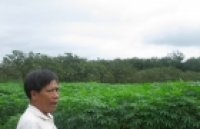| Resilience of cassava (Manihot esculenta Crantz) to salinity: implications for food security in low-lying regions. |
|
Rising sea levels are threatening agricultural production in coastal regions due to inundation and contamination of groundwater. The development of more salt-tolerant crops is essential. Cassava is an important staple, particularly among poor subsistence farmers. Its tolerance to drought and elevated temperatures make it highly suitable for meeting global food demands in the face of climate change, but its ability to tolerate salt is unknown. |
|
Gleadow R, Pegg A, Blomstedt CK. J Exp Bot. 2016 Oct; 67(18): 5403-5413. Epub 2016 Aug 9. AbstractRising sea levels are threatening agricultural production in coastal regions due to inundation and contamination of groundwater. The development of more salt-tolerant crops is essential. Cassava is an important staple, particularly among poor subsistence farmers. Its tolerance to drought and elevated temperatures make it highly suitable for meeting global food demands in the face of climate change, but its ability to tolerate salt is unknown. Cassava stores nitrogen in the form of cyanogenic glucosides and can cause cyanide poisoning unless correctly processed. Previous research demonstrated that cyanide levels are higher in droughted plants, possibly as a mechanism for increasing resilience to oxidative stress. We determined the tolerance of cassava to salt at two different stages of development, and tested the hypothesis that cyanide toxicity would be higher in salt-stressed plants. Cassava was grown at a range of concentrations of sodium chloride (NaCl) at two growth stages: tuber initiation and tuber expansion. Established plants were able to tolerate 100mM NaCl but in younger plants 40mM was sufficient to retard plant growth severely. Nutrient analysis showed that plants were only able to exclude sodium at low concentrations. The foliar cyanogenic glucoside concentration in young plants increased under moderate salinity stress but was lower in plants grown at high salt. Importantly, there was no significant change in the cyanogenic glucoside concentration in the tubers. We propose that the mechanisms for salinity tolerance are age dependent, and that this can be traced to the relative cost of leaves in young and old plants.
See https://www.ncbi.nlm.nih.gov/pmc/articles/PMC5049390/
Figure 1: Biomass, growth measurements, and tissue hydrogen cyanide potential (HCNp) of 6-month-old cassava plants grown at 0, 50, 100, and 150mM NaCl for 28 d (Experiment 1; n=7 for each treatment). (A) Above-ground biomass; (B) tuber biomass; (C) root:shoot ratio; (D) total leaf area; (E) foliar and tuber HCNp. Means (±SE) with different letters are significantly different at P<0.05. |
|
|
|
[ Tin tức liên quan ]___________________________________________________
|


 Curently online :
Curently online :
 Total visitors :
Total visitors :
(28).png)


